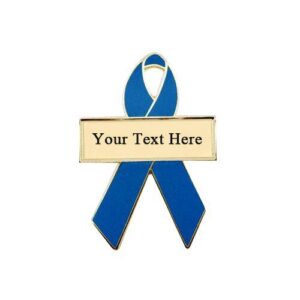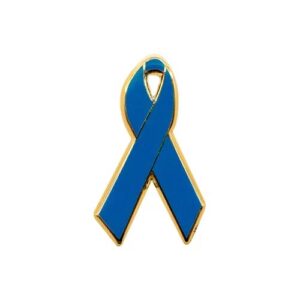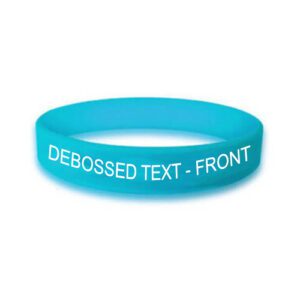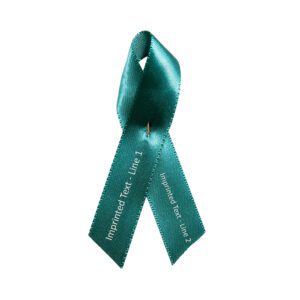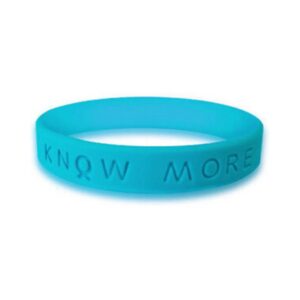Search by Color or Cause
$49.95
Wear your heart on your sleeve with a teal fabric awareness ribbon on your lapel.
Shop Personalized Cause for awareness ribbons, pins, and wristbands for over 1000 causes.
Our teal cloth fabric ribbons come in bags of 250 pieces (bulk).
Simple awareness ribbons started it all: a global movement for a better tomorrow. Today, an awareness ribbon is an iconic, worldwide symbol of hope for warriors and survivors, alike. For over twenty years, Personalized Cause has been at the forefront of the awareness ribbon movement, and strives to keep abreast of ever-changing awareness color and cause updates. Through this attention to cause awareness, Personalized Cause raises hope, encourages compassion, and highlights medical, social, mental health, autoimmune, and cancer causes. These causes are near and dear to many. Pin a ribbon to your lapel to show support for cancer research fundraisers or group marches for social change,
Personalized Cause has the most up-to-date and comprehensive awareness cause and color reference guide on the internet. Because of that, it has taken years to compile a list that is accurate and inclusive. You can find this extensive cause list under Awareness Ribbons Colors Causes and Meanings | Reference Guide. You can also use the Find Your Product search tool on the Home Page to find the product you’re looking for – search by color or cause.
Grosgrain ribbons primarily contain cotton, polyester and fiber blends. Satin ribbons, on the other hand, primarily contain nylon or polyester. Grosgrain ribbons also have thick horizontal fibers, whereas satin ribbons are smooth to the touch. Satin ribbons are much softer than grosgrain ribbons. Many people love satin ribbons for their beautiful shiny finish, allowing them to create a sleek look.
Double-faced satin ribbon is perhaps the most common type of satin ribbon available. Like the name suggests, this ribbon has two right sides. Therefore, it doesn’t matter what side faces upward or outward, as both of the sides look the same. The alternative is a single faced ribbon, which has a shiny outer side and a muted underside. Our satin ribbons are double-faced.
We offer these teal fabric awareness ribbons in bags of 250 pieces. Our ribbons are perfect for fundraising, awareness events, cancer races, awareness campaigns, support groups, school fundraisers, funerals, memorial gifts, and promotional products. Wearing awareness ribbons sends a subtle message that you support a cause. For example, it might mean you are raising awareness for a particular social cause. Another reason to wear a ribbon is to support a medical or mental health cause. Further, perhaps the ribbon represents a cause that personally connects to a cause affecting animals. Again, the ribbon sits on the left side of the chest or over the heart which is symbolic for a cause that is heartfelt.
Please note: We cannot personalize these ribbons. However, click here to see our personalized fabric ribbons in similar colors with an attached safety pin on the back of the fabric ribbon.
Teal Awareness Ribbons – Causes, Colors, Meanings and Months:
The primary causes associated with teal awareness ribbons are Sexual Assault, Anxiety Disorders, Autoimmune Diseases and Disorders, and Ovarian and Female Reproductive Disorders.
Sexual Assault
The term sexual assault refers to sexual contact or behavior that occurs without explicit consent of the victim.
Sexual Assault causes may include:
Adult Survivors of Child Sexual Abuse
Child Sexual Abuse
Child Sexual Assault
Rape
Sexual Assault
Sexual Violence
Another primary cause associated with teal awareness ribbons is Anxiety Disorders.
Anxiety Disorders
Often, anxiety disorders involve repeated episodes of sudden feelings of intense anxiety and fear or terror that reach a peak within minutes (panic attacks).
Anxiety Disorders causes may include:
Agoraphobia
Anxiety Disorders
Obsessive Compulsive Disorder
Another primary cause associated with teal awareness ribbons are Autoimmune Diseases and Disorders.
Autoimmune Diseases and Disorders
Autoimmune disorders are a group of diseases that occur when the body’s immune system mistakenly attacks healthy cells, tissues, and organs. There are more than 80 known autoimmune diseases,
Autoimmune Diseases and Disorders may include:
Juvenile Scleroderma
Myasthenia Gravis
Scleroderma
Systemic Sclerosis
Lastly, another primary cause associated with teal awareness ribbons is related to the Ovaries and Female Reproductive Disorders.
Ovarian and Female Reproductive Disorder causes may include:
Fallopian Tube Cancer
Ovarian Cancer
Polycystic Ovarian Syndrome / PCOS
Premature Ovarian Insufficiency
Premenstrual Dysphoric Disorder
Primary Peritoneal Cancer
Other Teal Ribbon Causes Include:
Anaphylaxis
Batten Disease
Dissociative Identity Disorder
Food Allergies
Fragile X Syndrome
Heterotaxy Syndrome
Interstitial Cystitis
Lichen Sclerosus
Occipital Neuralgia
Polycystic Kidney Disease / PKD
Post Traumatic Stress Disorder / PTSD
Progressive Supranuclear Palsy
Systemic Sclerosis
Tourette Syndrome
Trigeminal Neuralgia
Awareness Months for Teal Causes
Adult Survivors of Child Sexual Abuse Awareness Month – September
Agoraphobia Awareness Month – May
Anaphylaxis Awareness Month – May
Anxiety Disorders Awareness Month – May
Batten Disease Awareness Day – June 9
Child Sexual Abuse Awareness Month – April
Child Sexual Assault Awareness Month – April
Dissociative Identity Disorder Awareness Day – March 5
Fallopian Tube Cancer Awareness Month – September
Food Allergies Awareness Month – May
Fragile X Awareness Day – June 22
Interstitial Cystitis Awareness Month – September
Lichen Sclerosus Awareness Day – January 17
Martin Bell Syndrome Awareness Month – July
Myasthenia Gravis Awareness Month – June
Obsessive Compulsive Disorder Awareness Month – October
Occipital Neuralgia Awareness Month – October
Ovarian Cancer Awareness Month – September
Polycystic Kidney Disease / PKD Awareness Month – September
Polycystic Ovarian Syndrome / PCOS Awareness Month – September
Post Traumatic Stress Disorder / PTSD Awareness Month
Premature Ovarian Insufficiency Awareness Month – June
Premenstrual Dysphoric Disorder Awareness Month – April
Primary Peritoneal Cancer Awareness Month – September
Progressive Supranuclear Palsy Awareness Month – May
Rape Awareness Month – April
Scleroderma Awareness Month – June
Sexual Assault Awareness Month – April
Sexual Violence Awareness Month – April
Tourette Syndrome Awareness Month – May 15 to June 15
Trigeminal Neuralgia Awareness Month – October
WHAT IS THE HISTORY OF THE AWARENESS RIBBON?
In 1979, Penney Laingen’s husband was held prisoner during the Iran hostage crisis. To call attention to this, she placed yellow ribbons on trees in her neighborhood. She also created yellow ribbons for people to wear to show support for her husband and others being held hostage. This was the first time an awareness ribbon was used publicly as a way to silently voice support.
About ten years later, the group Visual AIDS used a bright red ribbon to represent awareness and support for AIDS and the lives lost to it. This trend caught on quickly. Awareness ribbons were so well accepted as a way to demonstrate support, in fact, that the New York Times declared 1992 as The Year of the Ribbon.
That was the same year the pink ribbon became associated with breast cancer. The Susan G. Komen Breast Cancer Foundation (now Susan G. Komen for the Cure) handed out pink hats to breast cancer survivors who participated in their Race for the Cure. Soon after, in 1992, Komen distributed pink ribbons to everyone who participated in the race.
The next big step came later that year. Alexandra Penney, editor of Self Magazine, produced their second annual Breast Cancer Awareness Month issue. This issue was inspired by Evelyn Lauder, Vice President of Estee Lauder. She was also a breast cancer survivor. Alexandra and Evelyn collaborated to create a pink ribbon to distribute in cosmetic stores throughout New York City. This action was so popular that eventually the pink ribbons were placed on cosmetics counters all across the United States during Breast Cancer Awareness Month.
That year, 1.5 million ribbons were distributed. On each one was a card that explained how to do self breast exams. They also collected over 200,000 petitions, asking the White House to provide additional funding for breast cancer research.
The next year, in 1993, popularity grew. Avon joined in the fight for breast cancer awareness and launched a pink rhinestone brooch in the shape of the pink awareness ribbon. In two years, sales from the pin raised over $10 million for breast cancer research. This visibility helped make everyone more aware of the need for research.
Many people believe that because of these awareness ribbons and the visibility they created, federal funding for breast cancer research increased from approximately $100 million in 1991 to over $550 million in 1996. This helped pave the way for pink ribbons and other colors, calling attention to the need for research money for causes such as autism, epilepsy, Alzheimer’s and many more.
Calling attention to various diseases and disorders, as well as social causes, is the impetuous behind awareness ribbons. Showing support and understanding can often make all the difference to those who struggle.
